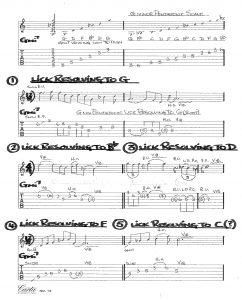 Robbie Calvo
Robbie Calvo
Go ahead and laugh at my title for this article. It’s not easy coming up with something that is intriguing yet subtle too, so I didn’t bother and went with this title instead! Last month I posed a couple of questions about your fretboard prowess and asked if you knew an Ami7 chord and an A minor Pentatonic Scale. I then asked if you really knew the chord and scale and what notes were in both. Given that you’ve had a month to figure it out, I’ve decided to approach the same question only using a Gmi7 chord and the G minor Pentatonic Scale instead. Why is he doing this to me? I hear you ask. Well, I want to expand your knowledge of the fretboard and give you something new to think about each month. If you figured out the notes in Ami7 and the A minor Pentatonic Scale all you have to do is transpose everything down a whole step (2 frets) to G. Better still let’s get to really know our guitar, the notes on the fretboard and the reason why we play the scales we do over certain chords and progressions.
Let’s begin by playing a Gmi7 bar chord at the 3rd fret. From low to high you should have G – D – F – Bb – D – G. If you have a seven string guitar go and get a pair of wire cutters 🙂 O.K., Now play the chord and name the notes. In our example, G is our root note, Bb is the minor 3rd, D is the 5th and F is the b7. Are you losing your marbles yet?
If you are still with me let’s move on to examine our G minor Pentatonic scale. (Pent – meaning 5, tonic meaning tones, so Pentatonic = 5 note /tone scale) The Minor Pentatonic scale is arguably the most played scale in guitar history and subjectively the easiest scale pattern to learn. Although this is one of the simplest forms of scale shapes we can learn to play, I urge you to not underestimate it’s vast potential in the realm of improvisation and it’s unlimited applications. If you truly know this scale and all of it’s variables you are truly a powerhouse of possibilities. To give you an idea of what I am talking about consider this;
We can apply the Minor Pentatonic scale in a global manner across all of the chords in a progression in one key. There are 12 keys and five Minor Pentatonic scale shapes per key.
We can apply the minor Pentatonic scale modally as if it were Dorian, Phrygian or Aeolian in all 12 keys. Then of course there are all of the relative major chords we can chord substitute with the minors! (you do the math).
There are 4 or more ways to apply the Minor Pentatonic Scale over altered dominant chords.
The list goes on. The bottom line is….If you know and I mean really know this scale shape, it’s notes in all keys, it’s inversions and all it can do there is already a life’s work under your fingers.
Slap me if I digress too much but I like to fill in the gaps as we go. The hardest part however of applying a scale to musical compositions is to understand how the melody (scale) relates to the Harmony (chord or chords). So , let’s analyze the G minor Pentatonic Scale over our G minor 7 chord.
Chord / Scale Analysis
CHORD = G – Bb – D – F
SCALE = G – Bb – C – D – F
We can see from this breakdown that the scale has one additional note over the chord and that note is C.
The C note in this scale over this chord is the weakest tone you can use and I would like to validate this by asking you to record if you can the Gminor7 chord as a simple sustained spread or a simple groove and then play and sustain each of the notes separately against the chord. You be the judge but the tones that are found in the chord and also in the scale are called ‘chord tones’ and these will always be your strongest notes to resolve licks and phrases to. My upcoming DVD on Truefire called ‘Sweetnotes’ deals with the topic of chord tones and resolutions exclusively and really outlines the whole concept in depth. Look for the release some time in July.
 Click to Enlarge
Click to Enlarge
I have written out five licks for you to learn and play. Licks 1 through 4 resolve to the 4 chord tones of the G minor 7 chord and Lick 5 resolves to the C note of the scale and is not a chord tone. You tell me which four are keepers and which one is the blooper!
I hope that lesson wasn’t too hard (or easy) but as they say ‘ No pain, No Brain’. I want you to learn something when you read these columns, so stick with me and we’ll expand upon this concept further next month. Please give me some feedback, we love to hear your thoughts. Oh! and by the way everything we cover is applicable to any genre of music….Thanks for listening!
-Robbie Calvo
Guitar Institute, London, Graduate
Guitar Institute , Hollywood, CA, Graduate
Guitar Instructor, Musicians Institute,G.I.T. London, ‘95 – ‘98
Guitarist Of The Year, London, (2nd Place) 1995
Little Walter Tube Amps Endorsee
B.B.C. TV. / PBS & Nashville Sessions
Click here to visit Robbie Calvo’s website.